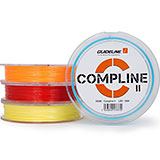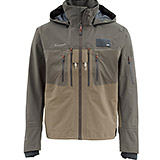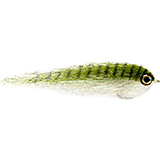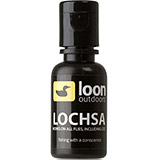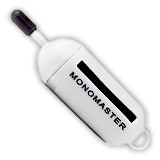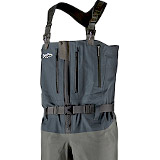Fly Fishing For Pike - The Perfect Fly Line
The flying line plays an important role in successful fly fishing for pike. Because it must transport your streamer through the wind, bring it to distance and load your rod quickly and efficiently. In this article we will tell you which line is the right one for you under which conditions.
First things first: There is no such thing as a ONE pike line that can cover every conceivable pike-water condition. It cannot exist at all, because fishing for Esox lucius is too varied, too diverse and differs too much according to water and season. Thus, wading in shallow water along the edge of a reed shortly after the closed season in May cannot be compared to winter fishing on large lakes, where you have to fish from a belly-boat with heavy sinking lines on edges or look for shoals of baitfish.
First things first
To find the right line and to be successful in pike fishing you should answer these three questions:
- At what depth do you want to present the streamer?
- How big is the fly?
- How far do you want or have to cast?

Pike Fishing in the Durch Polders - Brutal Attacks on short range
But before that you have to decide whether you prefer to fish with a full line or use a shooting head system (e.g. from OPST, which are getting more and more popular amongst predator fishermen). Although you are a bit more flexible with a shooting head and can quickly adapt to new conditions by just changing the tip (e.g. to fish deeper), most pike maniacs still prefer a classic fly line. These can be cast more relaxed and have the advantage that you can easily strip the streamer up to your own feet - and it is not uncommon for pike to attack during the last few metres.
The Taper
The selection of pike lines on the market has grown rapidly during the last years. Every well-known manufacturer has a special pike line (or a similar taper for casting big streamers) in their program. Regardless of the brand, the key characteristics of these special lines are always the same: All of them are WF (Weight Forward) lines. Due to their mostly relatively short head (short belly) and their aggressive taper, even heavy, bushy streamers can be cast easily and quickly. Even in harsh conditions - for example strong winds.
What is a WF line?
Fly lines differ not only in their swimming behaviour (floating vs. sinking), but also in their profile or construction (the so-called 'taper'). Traditionally, there are two important groups: DT and WF lines. DT stands for "Double Taper" and indicates that the fly line has a double tapered profile. The thickest part of these lines is therefore in the middle of the approximately 30 metre long line, while the two ends taper equally. In practice, DT lines mainly play a role in fine and light fishing, such as dry fly fishing, where particularly gentle casts are required. For pike fishing and casting large streamers, however, WF lines are intended. "WF" here stands for "Weight Forward" and means that the greatest weight is not in the middle of the line, but in the front part. This means that only a little line outside the tip ring of the rod is needed to load the rod well. With these lines the streamer can be stripped almost to the front of the feet and after only a few false casts it can be transported back to the horizon.
Head lengths of 8 to 11 m are most common for pike lines and have proven themselves in practice. Only if very long casts or gentler presentations with smaller streamers are required throughout, it is worthwhile to use lines with a slightly longer belly (e.g. a Vision Big Mama with a head length of approx. 12.8 m). These lines are more stable in the air and can be kept in the air longer. This is why they are often used for pike fishing from boats.
The head length is therefore important for a pike line. But what about the sink rate? As with shooting heads, all gradations can be found on full lines from the floating to the rapidly sinking variant. Here it depends very much on the water being fished and the season.

Efficient Casting thanks for the perfect taper
Sinking Rate
As you can see, the head length is very important for a pike line. But what about the sink rate? As with shooting heads, all gradations can be found on full lines from the floating to the rapidly sinking variant. Here it depends very much on the water being fished and the season.
What does sink rate mean?
Fly lines of each manufacturer have at least three parameters:
1. Profile, for example "DT" or "WF"
2. Line class (#0 - #12)
3. Sink rate.
First of all, a distinction is made between "F" (floating/floating), "I" (intermediate, slightly or very slowly sinking) and "S" (sinking). The last figure is often accompanied by a supplementary number (1 to 9). This number indicates the sink rate in "inches per second". Thus, a S1 sinks 1 inch per second, i.e. about 2.5 cm per second. So when buying a sinking line or sinking pike line you have to estimate how deep you want to fish on average or how long you want to wait until you start to strip in the streamer. It doesn't make much sense to fish with a S1 line in spots of 5 meters depth. Neither does a S9 make sense for fishing in knee-deep water near the edge of the reed. Here you would have to strip the streamer much too quickly to avoid hanging on the bottom all the time.
An "Intermediate" sinks very slowly - as mentioned above - and is ideal if you do not want to fish with a floating line (e.g. facing waves in strong winds). Especially in shallow water areas or on edges where the water drops to a maximum of 2 m, an Intermediate shows its full advantages. Often a combination of the above mentioned characteristics can be found in only one line. "F/I" means, for example, that the fly line is only an intermediate at the tip, whereas the rear part of the head and the running line are floating. These gradations are available in various combinations: Whether "I/S1" or "S3/S5". Especially these "Double Density" combinations have the advantage that no line belly is formed under water, but the complete line runs virtually in one line from the rod tip to the streamer. This gives you better contact with the fly and allows you to detect and exploit even cautious bites. This is why it is so important to keep constant contact with very heavy sinking lines (e.g. S8) even when the pike streamer is moved slowly. Otherwise cautious touches can easily be missed.
As a floating line you can actually use any short tapered WF on the market. For example the models from Guideline, Rio or Vision that are declared as pike lines. But also Short Belly Tapers from Scientific Anglers, Cortland or Loop are very well suited to cast even large and voluminous pike streamers due to their taper. It is an advantage if the line has a low stretch so that the hook can be set quickly and effectively. For beginners, a two-colour coating is an additional advantage. This makes it easier to find the sweet spot to shoot the line - this saves false casting and energy.

Clear and shallow water - A floating line is best here
Which sinking rate to choose?
If you want to stick to one line only, then many fly fishers fall back on an intermediate. Due to the speed of stripping and the waiting time for the line to sink, this sink rate gives you a wide range of water depths that can be covered. Popular models here come from Guideline, Loop or Vision, for example, which have been on the market for years almost unchanged, and not without reason. A F/I or F/H/I (float/hover/intermediate) is a good choice for those who can't make up their mind.

Fishing from the float tube with a sinking line
If you want to go one deeper in the water column, models with a sink rate from S/1 to S/4 come into play (often again in combination with two different sink rates). Popular lines here are the very compact Vision Grand Daddy or the Elbi's Special Pike from Airflo. Thanks to the very low stretch of its braided core, you can still feel the movement of the Streamer even in three or four metres of water depth. This is very important, especially when it comes to setting the hook after a bite into the hard pike mouth.
During winter fishing for pike - i.e. when the fish reduce their activity and follow the baitfish into very deep water sections - the heaviest sinking lines are used. There are several sink6 to a sink9 lines on the market that are excellent for pike fishing. Cortland in particular offers a wide range of heavy sink lines, which are used especially for fishing from the belly-boat. For shore fishing these lines are only conditionally suitable. Due to a long sinking phase and slow guiding of the streamer, even sluggish pike mums can be caught at great depth with these extreme sinking lines. A tip for everyone who wants to go pike fishing in the cold season with a float tube or boat!
 The right line allows casting with ease
The right line allows casting with ease
Quality Matters
In the end, there is not much that can go wrong when buying a pike line today. As long as you fall back on a quality line of the well-known manufacturers. Since the boom of pike fishing a few years ago, fortunately a lot of positive things have happened in this area and there is a wide range of very good lines for pike fishing - in all price ranges.
In our webshop you will find all the important pike lines on the current market with a lot of additional information. Some of our personal highlights we have put together for you here.
















